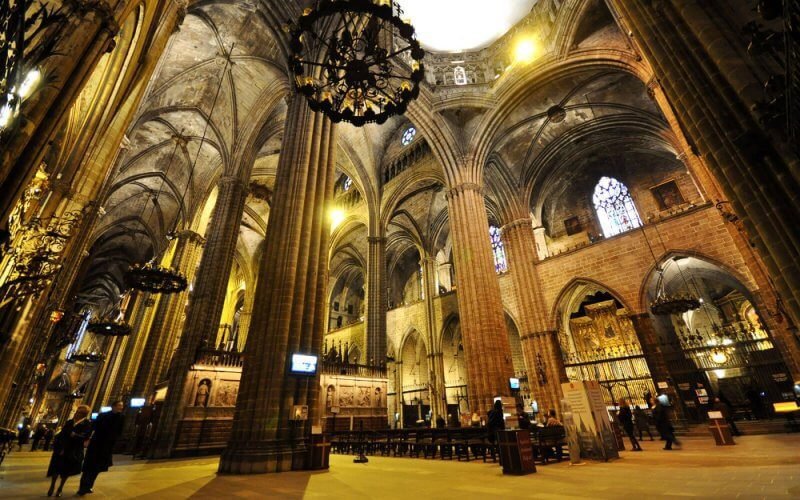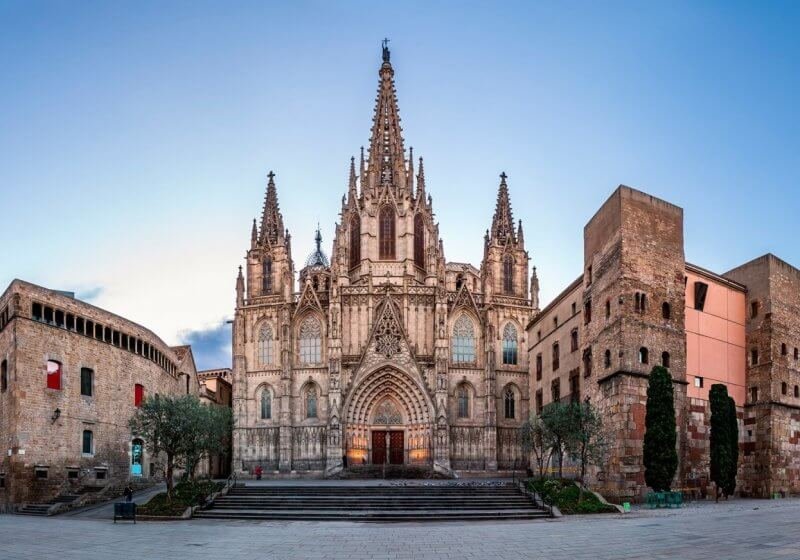From every corner of the Gothic Quarter, which occupies a significant part of the Old Town in Barcelona, you can see the spires of the city’s iconic landmark-the Cathedral. This monumental medieval church is also known as the Cathedral of the Holy Cross and Saint Eulalia, the Pulpit, the Cathedral of Saint Eulalia of Barcelona, the Cathedral of the Holy Cross, Barcelona Cathedral.
The Catholic Cathedral, where the Archbishop of Barcelona has set up his residence, is recognized as the main religious center of Barcelona.
A bit of history
Eulalia, a young 13-year-old girl who lived in the fourth century, was a humble Christian and brought faith in Jesus Christ to the people. During Diocletian’s persecution for her Christian faith, she was tortured and martyred at the hands of the Romans. She was later canonized as a Saint.
It is to the Holy Great Martyr Eulalia, who is one of the patronesses of the capital of Catalonia, that the Cathedral of Barcelona is dedicated.
The temple began to be built in 1298, choosing for this purpose a place above the crypt of the former chapel. Such large-scale construction required a lot of money, and since they were often not enough, the work periodically stopped. The official completion of construction works is called 1420, but the central facade was completed only in 1870 according to plans of the XV century, and the main spire was added in 1913.
In 1867, Pope Pius IX granted the Cathedral of Barcelona in Spain the status of a Minor Papal Basilica.

During the Civil War, the Cathedral was practically not damaged, unlike other churches in Barcelona. The powerful facade with its decorative elements and the interior of the building have been preserved almost intact.
Architectural solution
Barcelona Cathedral is a beautiful example of the Gothic style with vivid elements of Catalan culture. This building is very huge and massive, very well integrated into the Gothic quarter with its narrow winding streets. Despite its massiveness, the cathedral does not feel “heavy”, it seems to float in the air. This impression is largely created due to the many elegant details: flying up turrets-spires, slender columns, pompous Gothic “rosette” above the main entrance.
The pulpit has several portals: the central portal facing the square de la Seu and the oldest portal of St. Ivo, as well as the portals of Pietat, St. Eulalia, and St. Lucia facing the courtyard.
The facade of the building and the central portal are decorated with numerous statues of saints and angels, the main one is a statue of Christ in the arch.

The Cathedral of the Holy Cross in Barcelona is 40 meters wide and 93 meters high. The building is complemented by 5 towers, the largest of which is the central tower with a 70-meter spire and 2 octagonal chapels 50 meters high. On the right tower there are 10 small bells, on the left-a bell that weighs 3 tons.
Interior of the Pulpit
The Cathedral of Barcelona is very spacious, austere and majestic. Despite the huge number of beautiful multicolored stained glass windows and the presence of lighting, the building is always a mysterious semi-darkness.
Immediately from the main portal begins a vast central nave and 2 side chapels, separated from it by rows of slender columns. At a height of 26 meters, this spacious room is bounded by a gracefully airy dome.

A significant section of the central nave in the Cathedral of the Holy Cross is reserved for choirs made of carved wood, decorated with marble bas-reliefs. There are 2 rows of chairs, the backs of which are crowned with gilded coats of arms of the Order of the Golden Fleece.
The main decoration of the altar (XIV century) and at the same time a valuable religious relic is a statue of Christ of Lepant, made of wood. The statue was located on the bow of a ship belonging to the general Juan of Austria, and during the battle with the Turks in 1571, she saved the ship from destruction by taking on the impact of a flying shell. The statue was damaged, and now even with the naked eye you can see how twisted it is.
Next to the main altar, in the crypt, there is another important shrine: a sarcophagus standing on carved columns made of polished alabaster, in which the relics of Saint Eulalia rest.
In the back of the Cathedral hall, under the left tower-bell tower, there is an organ. It was made in 1539 and has since gone through many renovations. Since 1990, the organ has been used for concerts.

Courtyard of the Church of the Holy Cross
The Cathedral of the Holy Cross and Saint Eulalia in Barcelona has a very beautiful courtyard with a wonderful palm garden and an ancient fountain decorated with a statue of St. George. Other ancient artifacts include ground plates with monograms of medieval workshops that gave money for the construction of the cathedral.
Around the courtyard there is a covered gallery, the walls of which are decorated with numerous tapestries and bas-reliefs with scenes from the life of the patron saint of the city.
Along the perimeter of the gallery are 26 unique chapels facing it. In one of them, the chapel of the Bishop of St. Oligarius, there is an original cross with a crucifix of the XVI century. Adjacent to the courtyard is the oldest chapel of the cathedral, built in 1268, that is, several decades before the construction of the Cathedral of the Holy Cross itself.

On the territory of the courtyard, 13 snow-white geese graze, the place of residence of which is one of the chapels. The white color of these birds symbolizes the purity of the Great Martyr Eulalia, and their number – the number of years lived by the patroness of Barcelona.
Church Meeting Hall
The museum (this is the Hall of Church Meetings), has a very refined look. Along the inner perimeter of the walls, it is decorated with luxurious decorative finishes: purple velvet and elaborate carvings on dark wood.

Here is a collection of paintings, among which there are quite well-known, for example, engravings by Durer, a masterpiece of the XV century – “Pieta” by Bartolomeo Bermejo. The museum also houses tapestries, rich church utensils, a font, ancient crosses with crucifixes and altars.
Access to the Church Meeting Hall is possible through the inner gallery, through the courtyard.
Cathedral roof
To the left of the main portal of the Pulpit, elevators are installed that comfortably lift visitors to the roof of the structure – there is a convenient viewing platform near the dome.
From there, you can see the spire of the cathedral, as well as admire the Gothic Quarter and the panorama of the whole of Barcelona from above.

By the way, photos of Barcelona from the Cathedral are very successful and beautiful, like postcards.
Practical information
The address of Barcelona’s main religious attraction is Placa de la Seu, S / N, 08002.
Walking through the Gothic Quarter, the cathedral can be reached via Carrer del Bisbe, which opens onto Plaza de la Seu.
The Jaume I Metro station (line 4) is within walking distance.
Opening hours and cost of visits
The Church of the Holy Cross is open daily:
- on weekdays from 8: 00 to 19: 45 (entrance is closed at 19: 15);
- on Saturdays, Sundays and public holidays from 8: 00 to 20: 30.
Services are held from 8:30 to 12:30, and then from 17:45 to 19:30.

Whether a visit to the cathedral will be paid directly depends on the time of the visit:
- From 8: 00 to 12: 45, and then from 17: 15 to 19: 00, you can go inside for free. But it is worth considering that this time almost coincides with the time of worship, which is why the entrance for tourists may be limited.
- From 13:00 to 17:30, and on weekends from 14:00 to 17:00 admission is paid.
The price of an entrance ticket is also different, depending on what kind of sightseeing it provides.:
- ascent to the observation deck (paid even during the “grace period”) – 3 €;
- choir tour – 3 €;
- a single ticket that allows access to the choir stalls, the Chapel of St. Christ of Lepant and the Assembly Hall, as well as allowing access to the roof – 7 €.
The price is the same for both adults and children.
Enjoy Barcelona on a Budget: Free Entertainment Options
Useful tips
- You need to be prepared for the fact that the security at the entrance may conduct an inspection of things.
- Since the Cathedral is an active one, it is necessary to observe the appropriate dress code when visiting it: men and women in T-shirts without sleeves and with open knees (shorts and skirts) are not allowed to enter. At the entrance there is a box of shawls, you can tie them instead of a skirt or throw them over your shoulders.
- Climb to the roof of the cathedral to admire the views of Barcelona from above, best at 10-11 am, while there are still a few tourists.
- In the sarcophagus with the relics of Saint Eulalia, there is a special slot where you can drop a coin – the sarcophagus will be illuminated with beautiful lights.
- Organ concerts are held every month in the Barcelona Department Hall. You need to know about the schedule in advance.
- If you are going to the Cathedral of the Holy Cross and Saint Eulalia on foot in the Gothic Quarter, it is advisable to take a map with you: it is very easy to get lost in the old part of Barcelona.


